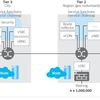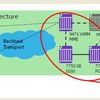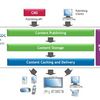By: Roland Mestric, Director, Video Solutions Marketing, Alcatel-Lucent
From original Alcatel-Lucent TechZine posting
This article provides guidance on network architecture choices for operators considering introducing the time-shifted TV services provided by cloud digital video recording (DVR) solutions. Time-shifted TV services include catch up, restart, pause live TV, and personal recordings. The same guidance applies to those wanting to deliver subscription-based VoD services—either their own or those of partners[1].
Forward thinking providers are already concerned that the coming wave of unicast traffic generated by popular on-demand video services will affect the delivery network from end to end. Clarifying the potential impact of these services on the network is vital as the ramifications could be significant.
Growth of unicast
In a traditional cable or IPTV network architecture—broadcast or multicast—traffic is proportional to the number of channels. Beyond a certain range and for a limited channel line-up, adding new subscribers has no traffic impact. Unicast is different. Traffic is directly proportional to the number of devices: more devices beget more traffic.
As illustrated in Figure 1, multicast traffic will flatten as the subscriber base grows, because the likelihood that users are watching all available TV channels increases. Meanwhile, unicast will continue to rise in step with subscriber growth.
Furthermore, knowing that the proliferation of connected devices is progressing rapidly, service providers don’t have the luxury of time. They need to get started on their transformation strategy now. Indeed, a Bell Labs study shows that metro video traffic will increase 720% by 2017.
Figure 1. Multicast and unicast traffic trends related to the number of subscribers
Key considerations
The paradigm shift from multicast to unicast impacts every aspect of the network—from access to the backbone. Figure 2 maps some of the key considerations to the network elements. Let’s look at how pay TV operators that want to offer personalized cloud TV services can re-imagine their network architecture from end to end.
Figure 2. Considerations for network design to support bandwidth demands of unicast traffic
Assess the situation
Before launching network-based time-shifted TV services, pay TV operators should model their cloud DVR solution. This includes identifying the type of services they will offer. Whether it is catch-up TV, restart TV, or personal recording, operators must understand the impact of these unique services on network transformation.
Here are several service characteristics to consider:
- Number of subscribers
- Level of concurrency (how many subscribers can access the service at the same time)
- Maximum throughput ramp-up time
- Video start-up time
- Number of TV channels
- Number of assets, such as TV programs, movies, personal recordings
- Size of assets
- Duration of assets
- Streaming protocols supported (constant bitrate, adaptive bitrates),
- Bitrate profiles for adaptive bitrate ranging from a few hundreds of kbps to a few Mbp.
Meet the capacity challenge
Volume — 100s of catch-up TV programs and 100s of hours of personal recording for a large subscriber base – makes for a significant storage capacity challenge. Multiple storage nodes have to be interconnected within a 10 GigE LAN topology to accommodate petabytes of programming.
As a result, designing an appropriate solution for scaling data center networks must consider:
- Quantity and locations for expected cloud DVR points of presence
- Internetworking requirements between cloud DVR nodes
- Disaster recovery requirements
Software-defined networking (SDN) will be a fundamental component in this design. SDN is already being used to automate connectivity within virtualized data center infrastructures and can establish connectivity between cloud DVR nodes upon their creation.
Prioritize the traffic
Once the cloud DVR is built, the next step is to feed the unicast streams into the network through an edge router—BNG/BRAS for an IPTV network, or a video router/CMTS in a cable hub architecture. Traditional edge routers were built to support highly oversubscribed, best-effort Internet connectivity. Today, however, they are becoming a bottleneck for increasing unicast video sessions. Consequently, they need to be upgraded or replaced. As traffic is growing, they are also being further distributed in the network.
At the edge, pay TV operators apply quality of service to pay TV traffic delivered to the set-top box (STB) as opposed to over-the-top (OTT) traffic receiving best-effort treatment. TV service to connected devices is often treated like an OTT service.
It’s time to revisit this practice. From the end-user’s point of view, connected devices are increasingly becoming the primary screen. That means best-effort service is no longer enough. This concern is pushing pay TV operators to reconsider how they mark and prioritize the traffic.
Scale the network
Backbone
Traffic growth on the backbone network can be managed using a content delivery network (CDN). The CDN caches the most popular content at the edge of the backbone. When the same asset is requested by multiple end users, it is served from the CDN cache. This approach significantly reduces bandwidth consumption within the backbone network.
In the event of strong user content demand, this approach also protects the origin server from high peak requests. This ensures that other critical functions, such as ingest, recording, encryption, packaging, and streaming remain unaffected.
A CDN dramatically cuts the cost of the origin server while reducing investment in legacy infrastructure. Investing in additional caches to serve popular content from the edge is more economical than adding capacity to the centralized origin servers.
Today many operators are growing their CDNs, using them as a unified infrastructure to serve traditional devices, such as STBs, as well as newer connected ones[2]. Typically, the CDN delivers content using HTTP over TCP, while the STB receives it using RTP over UDP, as shown in Figure 3. To receive content from the CDN, the STB connects to an RTSP pump that requests content from the CDN over HTTP. It does this using the industry-standard ATIS C2 interface[3].
Figure 3. Click to see the complete IP video infographic and learn more about the standards, protocols and acronyms.
Metro
According to the findings of a Bell Labs study, distributing the caches further into the metro network can reduce the total traffic by 41%. To optimize their service, pay TV operators must ask:
- How many caches?
- Where should they be located?
- How far into the network should they be distributed?
For the operator, there’s a trade-off here. Bandwidth savings need to be weighed against the extra cost of the caches. Alternatively, significant QoS improvements brought about by this distributed architecture might be sufficient to justify the investment.
Access
Pay TV operators need to evaluate the options to increase throughput per user in the access network. For fixed networks, one approach is to push fiber closer to end users. For example, some IPTV operators are deploying FTTx solutions or flexible micro-nodes with vectoring. Then they install fiber all the way to the home.
For their part, cable operators have several options to increase bandwidth. They can:
- Upgrade their hybrid fiber-coaxial (HFC) network by extending the frequency range with DOCSIS 3.1
- Reduce the split ratio of the HFC segment by installing a micro-cable modem termination system (CMTS) deep into the network and lower the number of homes per segment
- Deploy a passive optical network fiber-to-the-home (PON FTTH) as a future-ready solution
On mobile access networks where bandwidth is scarce, service providers are using a combination of techniques to improve user quality of experience (QoE) while reducing transport costs. Some techniques, such as transcoding, transrating, and compression can potentially decrease video resolution by transforming the content or streaming at lower rates. Other content distribution techniques that retain video resolution—buffering, caching, and broadcasting—can also be used to enhance QoE.
Knowledge is power
Introducing a cloud-based DVR service takes serious forethought and planning, and naturally leads to a transformation program. Considering the options requires a deep understanding of the complete video service delivery chain, as well as world-class expertise in IP backbone, metro, and access networks. The contribution of this knowledge and experience should be highly valued in developing a comprehensive cloud DVR service strategy and in selecting the right partners with the appropriate range of consulting and professional services.
Related Material
- Deeper than you think – Network Impact of Cloud DVR podcast
- Video streaming infographic
- The future of IP Video: From Pay TV to Cloud TV ebook
Footnotes
- [1] Netflix is already distributing its service via a number of pay TV set-top boxes ↩
- [2] To capture the enormous opportunities, pay TV operators are moving video delivery into the IP domain ↩
- [3] Consult the IP video infographic for more detail on video formats, protocols, and processing steps ↩
To contact the author or request additional information, please send an email to [email protected].












